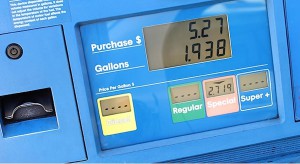After a long period of steady improvement, the fuel economy of new vehicles purchased by American consumers appears to have plateaued and if the price of fuel continues on its downward trend, mileage rating numbers are unlikely to improve anytime soon.
The gas mileage of new vehicles sold in the U.S. – as reflected on window stickers – stayed the same last month: 25.3 mpg, according to researchers at the University of Michigan Transportation Research Institute.
In fact, it was the same in September and October, but down from 25.8 mpg in August, but the reason for the leveling out is predictable.
“The unchanged average fuel economy is likely a net consequence of two opposing trends—less demand for more fuel-efficient vehicles because of the decreasing price of gasoline, and improved fuel economy of 2015 model year vehicles compared to 2014 model year vehicles,” said Michael Sivak, UMTRI researcher.
Earlier this week, OPEC elected to keep production levels unchanged, leading to speculation that gas prices are expected to remain below $3 a gallon in the U.S. through the first quarter of 2015. This means sales of less fuel-efficient vehicles should remain robust and keep the average fuel rating from improving during that time.
While the rating has stalled in recent months, overall vehicle fuel economy is up 5.2 mpg from October 2007, the first full month of monitoring by Sivak and fellow researcher, Brandon Schoettle. The corporate average fuel economy, or CAFE, rating is supposed to be 54.5 mpg by 2025, according federal regulations.
In addition to average fuel economy, Sivak and Schoettle issued a monthly update of their national Eco-Driving Index, which estimates the average monthly emissions generated by an individual U.S. driver.
The EDI takes into account both the fuel used per distance driven and the amount of driving — the latter relying on data that are published with a two-month lag.
(Plunging fuel prices could create problem for Ford. For more, Click Here.)
After four months of improvement, the EDI fell back to 0.78 in September from August’s record-low 0.76 (the lower the value, the better). The index currently shows emissions of greenhouse gases per driver of newly purchased vehicles are now down 22%, overall, since October 2007.
(Click Here for more about NHTSA’s nominee’s plans to speed up recalls.)
The changes in both indexes reflect the shift in consumer behavior in recent month. Demand for crossovers, SUVs and pickup trucks has steadily escalated while in the past 24 months, while the demand for small cars has dropped.
(To see the custom DB10 Aston Martin delivered for the new Bond movie, Click Here.)
Erich Merkle, sales analyst, Ford Motor Co., said this week the demand for small cars has dropped by 1% recently. John Krafcik, president of the car-buying service True Car, also noted that companies with strong crossover vehicle and truck products are also benefitting from the trend.

